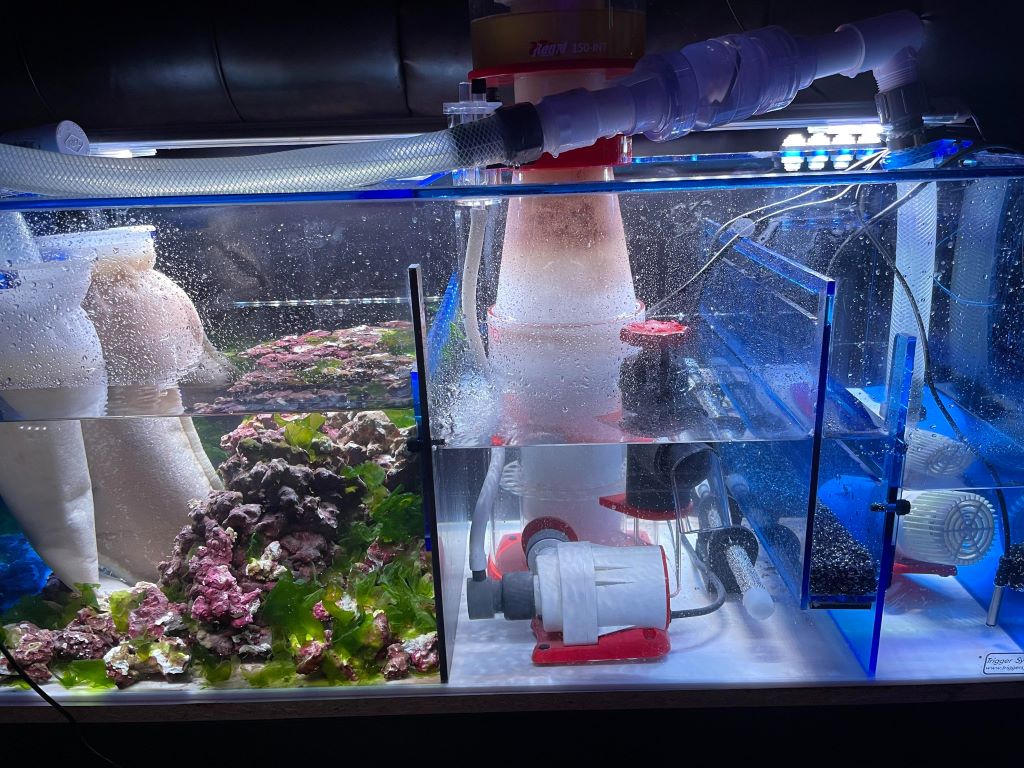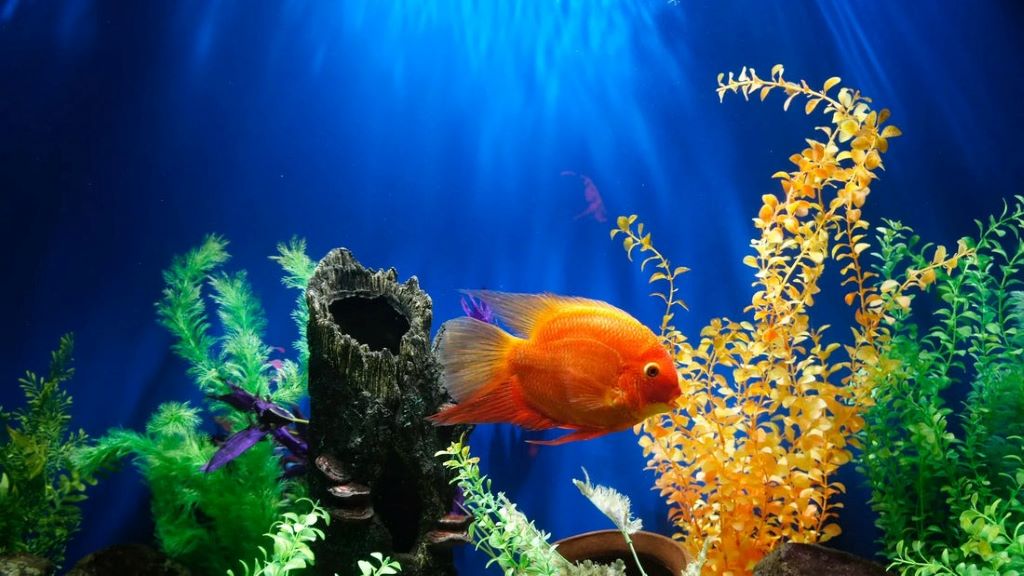A reef aquarium is a captivating microcosm of the ocean, teeming with vibrant corals, fish, and invertebrates. Maintaining the delicate balance of this ecosystem requires meticulous attention to water quality. This is where a sump filter comes in, acting as the heart of your reef tank’s life support system. Within this system, the reef aquarium sump filter media compartment plays a critical role by housing specialized filtration materials that scrub the water of impurities, ensuring clarity and purity to sustain the thriving aquatic life.
A sump filter is essentially an external filtration system that sits below the main aquarium. It provides a dedicated space for various filter media, equipment like protein skimmers and heaters, and a refuge for beneficial bacteria. While you can purchase ready-made sumps, building your own DIY sump filter allows for customization, cost savings, and a sense of accomplishment.
This comprehensive guide delves into the world of DIY reef aquarium sump filter media compartments, offering creative ideas and practical advice to help you construct an efficient and effective filtration system. We’ll also address frequently asked questions to ensure your DIY sump project is a success.
Understanding the Role of Filter Media
Before we dive into compartment design, let’s understand the different types of filter media and their functions in a reef aquarium sump:
- Mechanical Filtration: This is the first stage of filtration, responsible for removing large particulate matter like uneaten food, fish waste, and detritus. Common mechanical filter media include filter socks, sponges, and filter floss.
- Chemical Filtration: This stage targets dissolved impurities and pollutants in the water. Activated carbon is a popular chemical filter media that removes toxins, odors, and discoloration. Other options include GFO (Granular Ferric Oxide) for phosphate control and purigen for removing organic waste.
- Biological Filtration: This is arguably the most crucial stage, where beneficial bacteria colonize the filter media and break down harmful ammonia and nitrite into less toxic nitrates. Bioballs, ceramic rings, and live rock rubble are excellent biological filter media.
Designing Your Sump Compartments
The number and size of compartments in your DIY sump will depend on the size of your reef tank, the types of filter media you plan to use, and the equipment you want to house. Here are some popular compartment configurations:
-
The Classic Three-Chamber Design:
This is a simple yet effective design, ideal for beginner reefers.
- Chamber 1: Return Pump Chamber: This is where the return pump sits, drawing filtered water from the sump and sending it back to the main display tank.
- Chamber 2: Filter Media Chamber: This is the heart of the filtration system, housing various filter media like filter socks, bioballs, and chemical filtration media.
- Chamber 3: Refugium: This chamber provides a safe haven for macroalgae and copepods, which help consume nitrates and phosphates and serve as a natural food source for fish and invertebrates.
-
The Four-Chamber Design with Dedicated Protein Skimmer Chamber:
This design adds a dedicated chamber for a protein skimmer, which is a crucial piece of equipment for removing dissolved organic waste before it breaks down and pollutes the water.
- Chamber 1: Return Pump Chamber: Same as above.
- Chamber 2: Protein Skimmer Chamber: This chamber houses the protein skimmer, allowing for optimal performance and easy maintenance.
- Chamber 3: Filter Media Chamber: Same as above.
- Chamber 4: Refugium: Same as above.
-
The Five-Chamber Design with Frag Tank:
For experienced reefers who propagate corals, a five-chamber design with a dedicated frag tank is a great option.
- Chamber 1: Return Pump Chamber: Same as above.
- Chamber 2: Protein Skimmer Chamber: Same as above.
- Chamber 3: Filter Media Chamber: Same as above.
- Chamber 4: Refugium: Same as above.
- Chamber 5: Frag Tank: This chamber provides a controlled environment for growing and propagating coral frags.
DIY Sump Construction Materials

When building your DIY sump, it’s crucial to choose materials that are safe for your reef inhabitants and durable enough to withstand the aquatic environment. Here are some popular options:
- Acrylic: Acrylic is a lightweight, transparent, and easy-to-work-with material. It’s also relatively inexpensive and readily available.
- Glass: Glass is another popular choice, offering excellent clarity and durability. However, it’s heavier and more challenging to work with than acrylic.
- PVC: PVC is a cost-effective and durable option, but it’s not as aesthetically pleasing as acrylic or glass.
Building Your DIY Sump: Step-by-Step Guide
Once you’ve decided on your compartment design and materials, it’s time to start building your DIY sump. Here’s a general step-by-step guide:
- Plan and Measure: Carefully plan your sump design and measure the dimensions of each compartment. Consider the size of your reef tank, the equipment you’ll be housing, and the desired water level in each chamber.
- Cut and Assemble: Cut the acrylic or glass sheets to the required dimensions using a scoring tool or glass cutter. Assemble the sump box using aquarium-safe silicone sealant.
- Install Baffles: Install baffles between the compartments to control water flow and prevent filter media from migrating. You can use acrylic or glass sheets for the baffles, securing them with silicone sealant.
- Drill Holes: Drill holes for the return pump bulkhead fitting and any other necessary plumbing connections.
- Leak Test: Before setting up your sump, perform a thorough leak test to ensure all seams and connections are watertight.
- Add Filter Media and Equipment: Once the sump is leak-free, add your chosen filter media and equipment to their respective compartments.
- Connect Plumbing: Connect the sump to your reef tank using appropriate plumbing and valves.
- Cycle the System: Before adding livestock, cycle the sump and main tank to establish beneficial bacteria colonies.
How to Keep Sand Clean in a Reef Tank: A Comprehensive Guide
Popular FAQs about DIY Reef Aquarium Sumps
-
What size sump do I need for my reef tank?
A general rule of thumb is to choose a sump that’s at least 10-20% of the volume of your main display tank. However, larger sumps offer more stability and flexibility, especially if you plan to house a refugium or frag tank.
-
What is the best way to control water flow between sump compartments?
Baffles are the most common way to control water flow in a sump. You can adjust the height and spacing of the baffles to create different flow patterns and water levels in each chamber.
-
How often should I clean my sump?
Regular maintenance is crucial for optimal sump performance. Clean your filter socks or sponges weekly, and replace chemical filter media as needed. Perform a more thorough cleaning of the sump every few months, removing any accumulated detritus and cleaning the baffles and equipment.
-
Can I use tap water in my reef tank?
No, tap water contains chlorine, chloramine, and other chemicals that are harmful to reef inhabitants. You should always use purified water, such as RO/DI (Reverse Osmosis/Deionization) water, for your reef tank and sump.
-
How do I prevent noise from my sump?
Noise from the sump can be caused by various factors, such as the return pump, gurgling water, or vibrating equipment. To minimize noise, choose a quiet return pump, ensure proper water flow to prevent gurgling, and use vibration-dampening mats under equipment.
Conclusion
Building a DIY reef aquarium sump filter is a rewarding project that can significantly enhance the health and beauty of your reef tank. By carefully planning your compartment design, choosing appropriate materials, and following proper construction techniques, you can create a highly efficient and customized filtration system tailored to your specific needs. Remember to perform regular maintenance and address any issues promptly to ensure the long-term success of your DIY sump and the well-being of your reef inhabitants.
Read More:
A Comprehensive Guide to Cleaning Aquarium Light Fixtures




